It was late. The lights had dulled. I turned to leave, and there across the crowded bookstore, I saw it. A book like no other.
Timed to the subtle Barnes & Noble background minuet, I stepped near and ran a finger along it’s fine spine. It whispered a blurb just for me.
Finding himself the man of the family, London dancing master Alec Valcourt moves his mother and sister to remote Devonshire, hoping to start over. But he is stunned to learn the village matriarch has prohibited all dancing, for reasons buried deep in her past.
Alec finds an unlikely ally in the matriarch’s daughter. Though he’s initially wary of Julia Midwinter’s reckless flirtation, he comes to realize her bold exterior disguises a vulnerable soul—and hidden sorrows of her own.
Julia is quickly attracted to the handsome dancing master—a man her mother would never approve of—but she cannot imagine why Mr. Valcourt would leave London, or why he evades questions about his past. With Alec’s help, can Julia uncover old secrets and restore life to her somber village . . . and to her mother’s tattered heart?
Filled with mystery and romance, The Dancing Master brings to life the intriguing profession of those who taught essential social graces for ladies and gentlemen hoping to make a “good match” in Regency England.

It had me at Finding. With The Dancing Master tucked firmly in my grasp, I gave the attendant my coins and fled to a carriage, content in the knowledge I’d found a joy to keep me warm through the frigid Atlanta night.
Vanessa: Today at R&R we have Julie Klassen joining us. Julie, it is my pleasure to welcome you back to Regency Reflections.The Dancing Master ‘s premise really intrigues me. Normally, we see Regency books with the hero as a duke, a barrister, a spy, or maybe a doctor, but a dancing master, not so much. How did you come up with this idea?
Julie: In Regency England, dancing was one of a limited number of ways young men and women could spend time together or court one another. It was considered such an important social skill that parents hired dancing masters to come into the homes and teach their sons and daughters to dance. “Every savage can dance,” Mr. Darcy says, but unless one wished to dance very ill (Mr. Collins comes to mind) lessons were crucial. So, as an author of half a dozen other books set in the Regency era—and someone who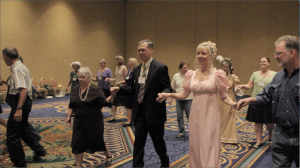 loves to dance–it was probably only a matter of time until I wrote about a dancing master. As I say in my author’s note, I learned to dance the box step standing atop my dad’s size 15 triple E shoes. Later, I went on to take every ballroom dance class I could sign up for at the University of Illinois. I even taught a few dance classes of my own through community ed. I enjoyed drawing on all of these experiences to write this book. Like ballroom dancing, I find English country dancing exhilarating, joyful, and just plain fun. I hope to express that joy in the novel.
loves to dance–it was probably only a matter of time until I wrote about a dancing master. As I say in my author’s note, I learned to dance the box step standing atop my dad’s size 15 triple E shoes. Later, I went on to take every ballroom dance class I could sign up for at the University of Illinois. I even taught a few dance classes of my own through community ed. I enjoyed drawing on all of these experiences to write this book. Like ballroom dancing, I find English country dancing exhilarating, joyful, and just plain fun. I hope to express that joy in the novel.
Vanessa: Wow, Dad has some big shoes to fill. Poor Mr. Klassen, has his work cut out for him, between dad and all of your romantic heroes. Tell me about what kind of research you conducted. Hopefully plenty of dancing.
Julie: I read instructional guides and journals written by dancing masters of ages past, and watched reenactors perform English country dances online. But the best and most enjoyable kind of research was actually learning dances from that period. My dear, long-suffering husband and I went English country dancing several times.

I also attended the annual general meeting of the Jane Austen Society of North America, held in Minneapolis in 2013. There, I took two more dancing classes to polish my skills before the “Netherfield ball,” complete with live musicians and costumes. It was a wonderful experience to dance with fellow Austen fans from around the world.
During the conference, we also watched a BBC production: “Pride And Prejudice: Having A Ball.” In this program, a team of experts recreated a private Regency ball, complete with historical food, costumes, music, and dances. Unlike most of the sedate dances we see performed in period movies nowadays, in reality many of the dances of the era were fast paced and lively. Those of us watching were surprised how energetic the dances were, and how the performers (trained dancers in their twenties) were breathing hard and perspiring after a few dances.
By viewing the program and taking the dance classes, I gleaned several details to include in The Dancing Master. For example, when a couple reaches the top or bottom of a long-ways set (line of dancers) they stand out for a round before working their way back up or down the line. This gives couples a breather, and more importantly, a chance to talk and flirt with their partners!
If you’d like to learn more about the JASNA conference, here’s a fun video my publisher took of me (in costume) at the event. http://www.youtube.com/watch?v=y5KmFKlJlfk
Vanessa: Ok, enough of the pleasantries. Julie, tell me about dreamy Alec Valcourt.
Julie: Alec is capable, loyal, and determined to support his mother and sister. He is a sharp dresser, prefers to keep his hands clean, and wields a fencing sword far better than an axe or spade in a rural village where most men are farmers or miners. As you can imagine, this leads to several painful scrapes along the way.
Vanessa: Why is Julia Midwinter the perfect foil to Alec?
Julie: Julia is a bit reckless, flirtatious, and difficult. But like many people in real life, there is more going on beneath the surface—and in her past—that has made her who she is. As the story unfolds and secrets are revealed, Alec begins to see the vulnerable, wounded soul beneath the brash exterior. He learns to understand her and becomes fond of her, especially as she begins to grow and change, and I hope readers will follow his lead.
Vanessa: Growing and changing. Sigh. I know I’ve made a few mistakes on that road. What spiritual truth would have made a difference to Julia, if she had realized it at the beginning?
Julie: All her life, she had been seeking a father’s love and approval. And if she could not have a father’s love, then any man’s approval would do. She had strived so long and so hard to gain attention in the wrong ways and from the wrong people…. If Julia had realized earlier that even though her earthy father failed her, her heavenly father loved her and highly valued her–she might have avoided some of the foolish things she did to try to fill the void left by the absence of a father’s love.
Vanessa: After reading Julia’s and Alec’s story, what else do have for us. There will be more cold nights in Atlanta.
Julie: I am currently working on rewrites for my next Regency-era novel with Bethany House Publishers. It’s a mysterious romance called The Secret of Pembrooke Park, and is due to be released December 2014.
Vanessa: Julie, The Dancing Master, is an amazing book. Asking this of any author is unfair, but if you could sum up the spiritual journey in one word what would it be?
Julie: Grace. I enjoyed weaving in grace in its many forms–social graces, grace in dancing, and most importantly, God’s grace—and I hope readers will be reminded of His amazing grace for us all.
Vanessa: Thank you for being a great sport and sharing this special book with us.
Julie: Thank you for having me here!
Julie Klassen is going to give away a paperback or e-book copy of The Dancing Master to one lucky commenter. Share with us your favorite dance, dance scene, or dance disaster. Mine took place at last year’s RWA conference when I tried to do a reel. There’s video….
Any way, here’s an excerpt from The Dancing Master:
“May I help you with something, Miss Midwinter?” Alec said officiously, hoping to chase the self-satisfied grin from her face.
“Yes, actually.” She clasped her hands. “I’ve come for a dancing lesson. Here—since Lady Amelia would never allow it in the house.”
He licked dry lips and felt his pulse rate quicken. Part of him relished the notion of being alone with Miss Midwinter. Enjoying her company and her undivided attention. Taking her hand in his to lead her through a private dance in a deserted churchyard . . . His chest tightened at the thought.
But he knew all too well the possible consequences of such stolen moments. Such seemingly innocent beginnings.
She took a step forward, and he stepped back. She performing the chassé,and he performing the dance of retreat.
He said, “Miss Midwinter. Before we proceed any further, I must tell you that I have a strict policy against any romantic involvement with my pupils.”
She blinked, momentarily taken aback. “In that case, perhaps I ought to reconsider becoming a pupil of yours.”
“Perhaps you should.”
You can purchase your own copy at: Amazon BN Christianbook.com
 JULIE KLASSEN loves all things Jane—Jane Eyreand Jane Austen. A graduate of the University of Illinois, Julie worked in publishing for sixteen years and now writes full time. Three of her books have won the Christy Award for Historical Romance. She has also won Christian Retailing’s BEST Award and has been a finalist in the Romance Writers of America’s RITA Awards. Julie and her husband have two sons and live in St. Paul, Minnesota.
JULIE KLASSEN loves all things Jane—Jane Eyreand Jane Austen. A graduate of the University of Illinois, Julie worked in publishing for sixteen years and now writes full time. Three of her books have won the Christy Award for Historical Romance. She has also won Christian Retailing’s BEST Award and has been a finalist in the Romance Writers of America’s RITA Awards. Julie and her husband have two sons and live in St. Paul, Minnesota.
Find Julie at: Her Blog or FaceBook


![StrangersSecret_final[1][1]](http://christianregency.com/blog/wp-content/uploads/2015/01/StrangersSecret_final11-197x300.jpg)
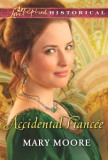
 Lord James Griffin disappeared into the wilderness of Brazil five years earlier, leaving his fiancée behind. Now he is back with his white monkey and gold earring and expects his lady love to have waited for him.
Lord James Griffin disappeared into the wilderness of Brazil five years earlier, leaving his fiancée behind. Now he is back with his white monkey and gold earring and expects his lady love to have waited for him.
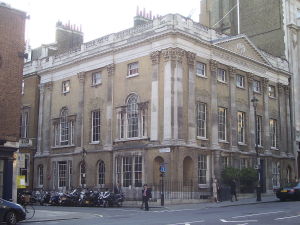


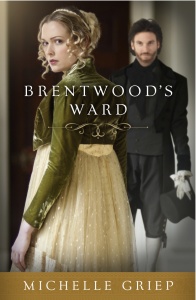

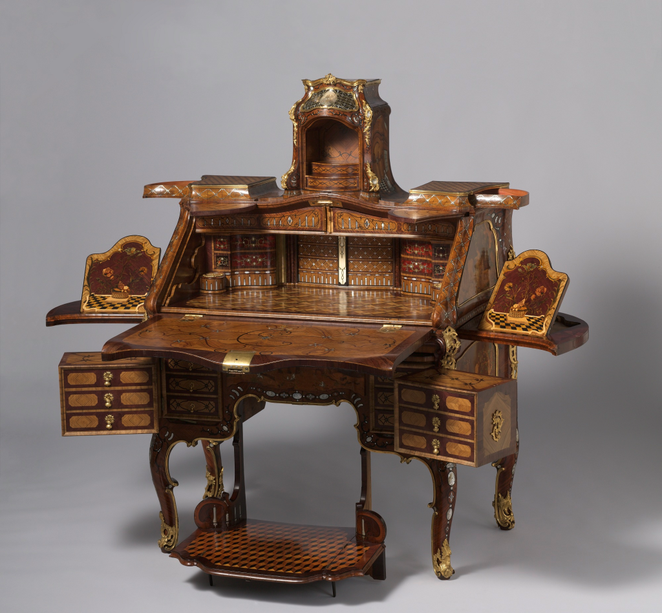
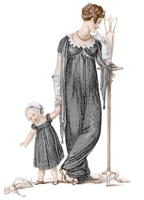
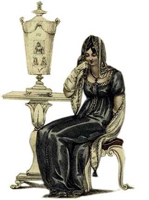 Full mourning (or deep mourning) was the first stage. During this stage, a woman would dress in all black – typically bombazine (heavier silk), crepe (lightweight silk treated to have no sheen), sarsnet, gossamer, and velvet – and she would accessorize with a mourning bonnet, black shawl, black gloves, widow’s cap, and/or a crepe veil. The only acceptable jewelry for full mourning was that of jet, black enamel, black glass, or amber. Embellishments, such as buckles or buttons, needed to be modest. While in full mourning, a woman was expected to abstain from social activities.
Full mourning (or deep mourning) was the first stage. During this stage, a woman would dress in all black – typically bombazine (heavier silk), crepe (lightweight silk treated to have no sheen), sarsnet, gossamer, and velvet – and she would accessorize with a mourning bonnet, black shawl, black gloves, widow’s cap, and/or a crepe veil. The only acceptable jewelry for full mourning was that of jet, black enamel, black glass, or amber. Embellishments, such as buckles or buttons, needed to be modest. While in full mourning, a woman was expected to abstain from social activities.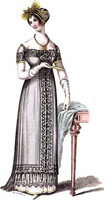




 Pale Skin
Pale Skin